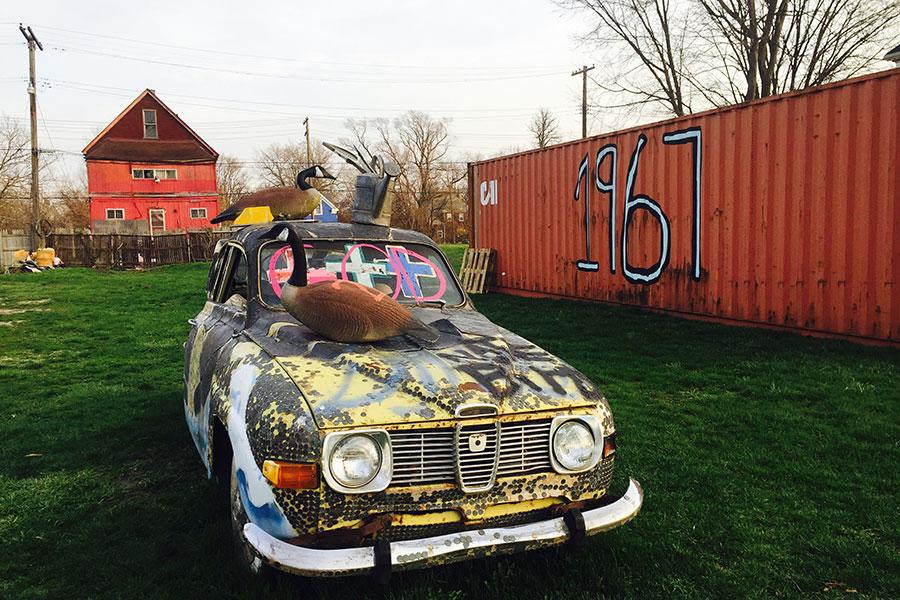How Tyree Guyton’s Heidelberg Project Helped Revitalize Detroit
Jenenne Whitfield, the artist's wife and president of the Heidelberg Project, reflects on the history and legacy of Guyton's magnum opus: an outdoor sculpture in Detroit's east side
Jenenne Whitfield, the artist's wife and president of the Heidelberg Project, reflects on the history and legacy of Guyton's magnum opus: an outdoor sculpture in Detroit's east side

In 1986, Tyree Guyton started work on the Heidelberg Project – an outdoor sculpture in an urban community on Detroit’s east side – with the help of his grandfather, Sam Mackey, an artist in his own right. Guyton knew he wanted to be an artist at the age of nine, when his grandfather first placed a paintbrush in his hand. ‘It was like my hand was on fire,’ he tells me.
Transforming and weaving discarded materials and society’s waste into the landscape of his neighbourhood, the artist cast a spotlight on the high levels of poverty and neglect in the area, evoking a flurry of emotions and reactions from people from all walks of life. Fittingly, a welcome sign describing the installation on Heidelberg Street reads: ‘SAYING, SEEING AND FEELING ALL THINGS.’

Guyton maintained that his artwork could be an engine for revitalization and change. Growing up impoverished, against a backdrop of drugs and crime, angered him: ‘Sometimes, I would look around at my community and see how people were living, and I’d want to explode.’ Channelling his own feelings of despair into more than just an open-air art museum, the Heidelberg Project serves as a street ministry for his community.
Art enthusiasts, naysayers and the simply curious came from all over the world to see Guyton’s ‘Ghetto Guggenheim’ – a term I coined that has been repeatedly used to describe the work – often leaving with more than just a visual experience. If you were lucky, you might catch Guyton working on a new assemblage and would likely be given a philosophical lesson in the artist’s own form of numerology, in which 2 + 2 = 8. When I first visited the Heidelberg Project in 1993, I asked Guyton: ‘What in the hell is all of this?’ He invited me to get out of my car and check it out. We talked for about an hour, and my soul was stirred;
I returned the next day and stayed.

Prior to COVID-19, according to guestbook records, the Heidelberg Project received more than 150,000 visitors annually, from 144 countries, making it the third-most-visited cultural attraction in Detroit, while a 2017 Williams College economic-impact study calculated that it generated more than US$7 million in revenue for the Wayne County region. Having been featured in countless national and international news publications over the years, in March 2020, the Heidelberg Project received the award for Best Cultural Activation from Leading Culture Destinations – an organization dubbed by The New York Times ‘the Oscars of the museum world’.
In 2016, on the project’s 30th anniversary, Guyton publicly announced that he would dismantle his work to make way for a new vision that he called Heidelberg 3.0. ‘I took the elevator up 30 floors and now I’m coming down. I want to see it from both sides,’ he said. In 2019, with the project still not fully disassembled, Guyton was asked by a member of his community what was taking him so long. ‘It took me 30 years to create this work,’ he replied. ‘As I come down this elevator, I am stopping on every floor.’ For Guyton, the act of dismantling the work is just as significant a part of the artistic process as creating it.

For 35 years, the Heidelberg Project has brought diverse people together, serving as inspiration for generations of innovators in Detroit and across the world. Guyton concedes that the ramifications of his work are much bigger than the man who created it. The Heidelberg Project deserves a deeper dive and investment to test Guyton’s theories or, at the very least, a review of its achievements. We can only hope that Detroit will eventually catch up to Guyton who, at 65, is never standing still.
This essay is part of a series on public art that will appear in the May issue of frieze.
Main image: Street view of Tyree Guyton's Heidelberg Project. Courtesy: the artist and the Heidelberg Project, Detroit














